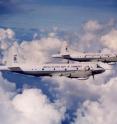Study links springtime ozone increases above western North America to emissions from abroad
Springtime ozone levels above western North America are rising primarily due to air flowing eastward from the Pacific Ocean, a trend that is largest when the air originates in Asia. Such increases in ozone could make it more difficult for the United States to meet Clean Air Act standards for ozone pollution at ground level, according to a new international study. Published online today in the journal Nature, the study analyzed large sets of ozone data captured since 1984.
"In springtime, pollution from across the hemisphere, not nearby sources, contributes to the ozone increases above western North America," said lead author Owen R. Cooper, of the NOAA-funded Cooperative Institute for Research in Environmental Sciences at the University of Colorado at Boulder. "When air is transported from a broad region of south and east Asia, the trend is largest."
The study focused on springtime ozone in a slice of the atmosphere from two to five miles above the surface of western North America, far below the protective ozone layer but above ozone-related, ground-level smog that is harmful to human health and crops. Ozone in this intermediate region constitutes the northern hemisphere background, or baseline, level of ozone in the lower atmosphere. The study was the first to pull together and analyze nearly 100,000 ozone observations gathered in separate studies by instruments on aircraft, balloons and other platforms.
Combustion of fossil fuels releases pollutants like nitrogen oxides and volatile organic compounds, or VOCs, which react in the presence of sunlight to form ozone. North American emissions contribute to global ozone levels, but the researchers did not find any evidence that these local emissions are driving the increasing trend in ozone above western North America.
Cooper and colleagues from NOAA's Earth System Research Laboratory in Boulder and eight other research institutes used historical data of global atmospheric wind records and sophisticated computer modeling to match each ozone measurement with air-flow patterns for several days before it was recorded. This approach essentially let the scientists track ozone-producing emissions back to a broad region of origin.
This method is like imagining a box full of 40,000 tiny weightless balls at the exact location of each ozone measurement, said Cooper. Factoring in winds in the days prior to the measurement, the computer model estimates which winds brought the balls to that spot and where they originated.
When the dominant airflow came from south and east Asia, the scientists saw the largest increases in ozone measurements. When airflow patterns were not directly from Asia, ozone still increased but at a lower rate, indicating the possibility that emissions from other places could be contributing to the ozone increases above North America.
The study used springtime ozone measurements because previous studies have shown that air transport from Asia to North America is strongest in spring, making it easier to discern possible effects of distant pollution on the North American ozone trends.
Ozone-measuring research balloons and research aircraft collected a portion of the data. Commercial flights equipped with ozone-measuring instruments also collected a large share of the data through the MOZAIC program, initiated by European scientists in 1994. The bulk of the data was collected between 1995 and 2008, but the team also included a large ozone dataset from 1984.
The analysis shows an overall significant increase in springtime ozone of 14 percent from 1995 to 2008. When they included data from 1984, the year with the lowest average ozone level, the scientists saw a similar rate of increase from that time through 2008 and an overall increase in springtime ozone of 29 percent.
"This study did not quantify how much of the ozone increase is solely due to Asia," Cooper said. "But we can say that the background ozone entering North America increased over the past 14 years and probably over the past 25 years."
The influence of ozone from Asia and other sources on ground-level air quality is a question for further study, Cooper said. Scientists will need to routinely measure ozone levels close to the surface at several locations along the West Coast to see whether similar trends are impacting ground-level air quality.
Source: University of Colorado at Boulder
Other sources
- Study Links Spring Ozone Over North America With Emissions Abroadfrom NASA Jet Propulsion LaboratoryThu, 21 Jan 2010, 17:42:13 UTC
- Study links springtime ozone increases above western North America to emissions from abroadfrom Science BlogThu, 21 Jan 2010, 13:14:27 UTC
- Asian ozone raising levels of smog in western United States, study showsfrom The Guardian - ScienceThu, 21 Jan 2010, 12:07:16 UTC
- Winds carry Asian smog component to western U.S., study findsfrom LA Times - ScienceThu, 21 Jan 2010, 5:21:14 UTC
- Study Links Spring Ozone Over North America With Emissions Abroadfrom NASA Jet Propulsion LaboratoryWed, 20 Jan 2010, 23:42:15 UTC
- Another Made in China Import: Smogfrom CBSNews - ScienceWed, 20 Jan 2010, 20:14:24 UTC
- Study links springtime ozone increases above western North America to emissions from abroadfrom Science BlogWed, 20 Jan 2010, 19:56:39 UTC
- Springtime ozone increases above western North America linked to emissions from abroadfrom Science DailyWed, 20 Jan 2010, 19:28:19 UTC
- Ozone pollution in N. America linked to Asiafrom CBC: Technology & ScienceWed, 20 Jan 2010, 19:07:21 UTC
- Springtime ozone increases over Western North America linked to emissions abroadfrom PhysorgWed, 20 Jan 2010, 18:07:25 UTC
